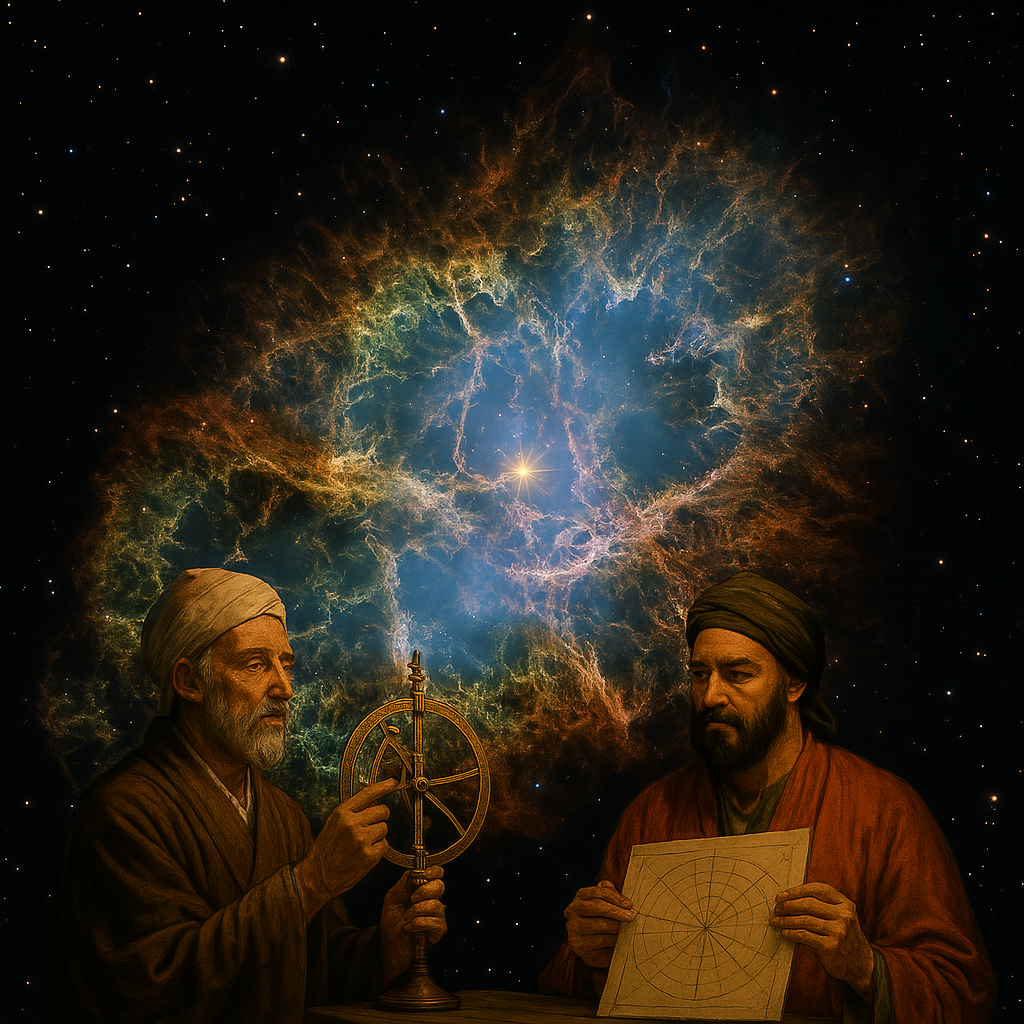A Blaze in the Medieval Sky
On July 4th, 1054 CE, the heavens above Asia and the Middle East erupted in an otherworldly brilliance. Ancient Chinese court astronomers gazed upward to record a “guest star” that outshone Venus and burned steadily in daylight for weeks. In the same months, skywatchers in Baghdad and Córdoba noted its fiery arrival, describing a shining orb that hovered in Taurus. To those medieval observers, this sudden beacon challenged every assumption about an unchanging firmament and sparked a wave of meticulous record-keeping that would echo for a millennium.
Over two years the star faded from view, yet its legacy endured. Chinese archive scrolls detailed its precise coordinates relative to known lunar lodges, while Abbasid scholars sketched its shifting hues. Though they lacked telescopes or modern physics, they grasped the importance of careful observation. Their combined logs later enabled astrophysicists to pinpoint the blast’s remains: the now-famous Crab Nebula. What began as a flash in a distant sky became a cornerstone of cosmic discovery.
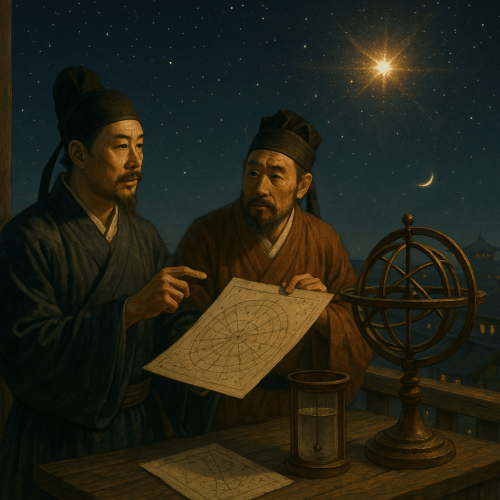
## The Chinese Astronomical Bureau
In the Northern Song Dynasty, Kaifeng’s Astronomical Bureau was a marvel of precision. Emperors entrusted court scholars with the mandate to record every celestial event. Observatory towers crowned strategic hills, equipped with armillary spheres, gnomons, and clepsydrae to track the sun’s shadow and measure time in hours and moments. Each night, teams of astronomers lined up bamboo sighting tubes toward the horizon, logging planetary motions and star positions with ink on silk annals.
Their cosmology blended ritual, astrology, and empirical data. The Mandate of Heaven demanded that lunar eclipses and comets portend political omens. Yet when the 1054 star appeared, scholars recognized that it was unlike any omen—they classified it as a “guest” rather than a harbinger of disaster. Over 23 daylight sightings and nearly two years of nightly watches, they recorded its magnitude, color changes, and precise lunar lodge coordinates. These entries survived fires and wars, a testament to the Imperial Bureau’s unyielding discipline.
This system of celestial accountability was unique. Aristotelian thought held that the heavens were perfect and eternal, immune to change. Chinese astronomers, however, treated anomalies as data points to be investigated, not dismissed. Their records bridged observation and curiosity—an approach that inadvertently laid groundwork for modern scientific methodology.
## Islamic Skywatchers and the Translation Movement
While Chinese scholars chronicled the new star in the east, Islamic astronomers in Baghdad and Córdoba seized upon it in the west. The Abbasid Caliphate’s House of Wisdom had already translated Ptolemy’s Almagest and Indian Siddhantas into Arabic, creating a vibrant intellectual marketplace. When the guest star flared, scholars such as Ibn Sīnā (Avicenna) and al-Bīrūnī made careful notations in their celestial notebooks.
In kayrawan courtyards and marble-pillared observatories they sketched the star’s relative position, coupling Greek trigonometry with Arabic numerals to refine its coordinates. They reported that its color shifted from a brilliant white to a soft red over months—a clue to the cooling debris expanding into space. Though without telescopes, they understood that stellar phenomena could be dynamic and complex.
These scholars also debated the star’s nature. Was it a combustion in the upper atmosphere, an omen from the divine, or a true celestial birth? Their discourses blended theology, astrology, and nascent physics, reflecting a culture that prized both faith and reason. Their manuscripts traveled along caravan routes to North Africa and al-Andalus, where Andalusian scholars further enriched the dialogue.
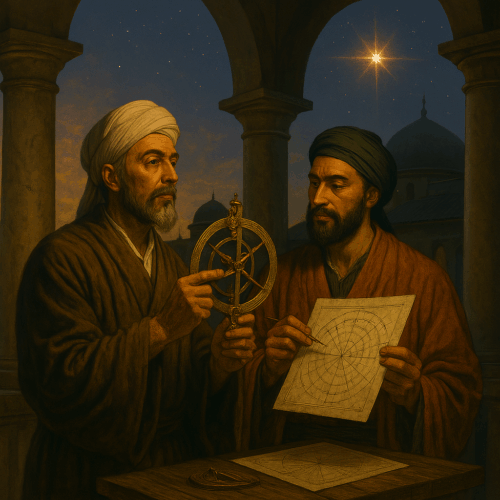
## A Fusion of Traditions
The cross-cultural dialogue between East and West set a rare precedent. Chinese positional logs and Arab color observations, when later combined, gave astronomers a more complete picture of the event. European scholars in the Renaissance rediscovered these ancient manuscripts, translating them into Latin and weaving them into emerging astronomical treatises. By the time of Tycho Brahe in the late 16th century, the notion of changing heavens was gaining traction, setting the stage for Galileo’s telescopic revelations.
When telescopes finally pierced the sky in the early 17th century, astronomers sought archival records of past novae. Though none in Europe matched the brilliance of 1054, the Chinese and Arabic accounts guided them to search the region in Taurus. The Crab Nebula first appeared in telescopic sketches in 1731 by John Bevis and later in Charles Messier’s catalog as M1 in 1758. Its diffuse halo and filamentary tendrils hinted at an explosive origin unlike any comet or planetary nebula known.
## Observing the Crab Nebula Through the Ages
From simple refractors to modern observatories, the Crab Nebula has remained a target of fascination. William Herschel’s telescopes in the late 18th century showed a faint, gossamer cloud; photographic plates in the late 19th century revealed wispy filaments; and by the mid-20th century, radio telescopes mapped its synchrotron emissions. Spaceborne instruments added new dimensions: X-ray observatories like Chandra exposed a glowing torus and jets, while Hubble’s optical camera captured braided shockwaves.
At the nebula’s core spins the Crab Pulsar, discovered in 1968 by radio astronomers Jocelyn Bell Burnell and Anthony Hewish. This neutron star, compressed to city-size mass and spinning thirty times every second, beams pulses of radiation like a cosmic lighthouse. Its energy powers the nebula’s glow, offering a laboratory for extreme physics—magnetic fields, relativistic particles, and plasma behaviors that no Earthbound experiment can replicate.
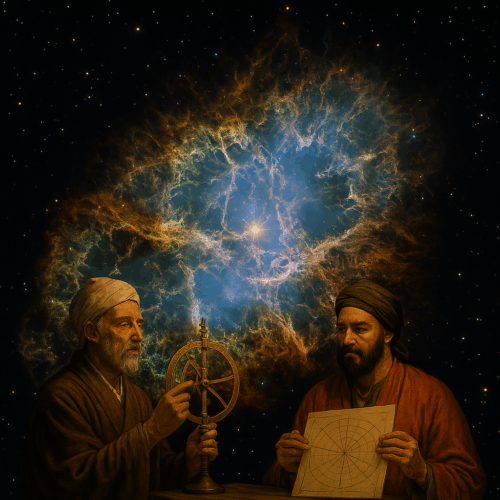
## Scientific Significance Across a Millennium
The supernova of 1054 did more than light up medieval skies. It became a calibration point for astrophysics. By measuring the expansion rate of the nebula’s filaments and comparing it with the date of the medieval observations, scientists confirmed core-collapse supernova models. This, in turn, informed our understanding of chemical element formation: the shockwave forged heavy elements that seeded future star systems and planets—including the Earth itself.
Moreover, the collective effort of Chinese, Arab, and European scholars illustrates the collaborative nature of scientific progress. Ideas and data flowed across silk roads and Mediterranean seas, transcending language and culture. The global tapestry of knowledge built a foundation for modern international research—collaborative projects like the James Webb Space Telescope or CERN’s particle accelerators echo this spirit of shared inquiry.
## Personal Application: Illuminating Your Path
Though the 1054 supernova unfolded in distant skies, its story holds down-to-earth lessons for anyone seeking growth and inspiration today. The medieval scholars’ combination of curiosity, methodical logging, and cross-cultural exchange can guide personal habits and professional practices.
– Embrace Meticulous Observation
Just as Song astronomers tracked the guest star day after day, cultivate a habit of daily reflection. Journal your accomplishments, surprises, and questions. Over weeks, patterns emerge—revealing strengths to amplify and blind spots to address.
– Seek Diverse Perspectives
Medieval skywatchers gathered data across continents. In your life, build networks beyond familiar circles. Attend webinars in unrelated fields, read books outside your genre, or simply ask colleagues in other departments to share their challenges.
– Document and Revisit
Archive your notes in organized folders or digital spreadsheets. Tag entries by theme—innovation, relationships, obstacles. Quarterly, review and refine. You’ll discover evolving trends and unlock actionable insights buried in past entries.
– Project Beyond the Immediate
The Crab Nebula’s story spans a thousand years. Define a long-term vision that reaches beyond the next quarter or year. Whether it’s a five-year career blueprint or a decade-long passion project, set milestones and dream boldly.
– Build Resilience Rituals
Sudden changes—projects paused, markets shifted—mirror unpredicted celestial novae. Develop mental and physical resilience: mindfulness exercises, regular movement breaks, or creative hobbies. When the unexpected arrives, you’ll navigate with steadiness.

## Your 90-Day Supernova Plan
This structured plan borrows from medieval diligence and global collaboration, translating cosmic insights into personal progress.
### Month One: Observation and Recording
Week 1: Establish a daily morning and evening journal ritual (5–10 minutes each). Note one unexpected positive event and one question that intrigued you.
Week 2: Create a digital “Curiosity Log.” Record three observations about your work, relationships, or creative spark. Tag each by category.
Week 3: Share one entry with a mentor or friend. Invite their perspective and document new insights.
Week 4: Review all eight weeks of notes. Identify two recurring themes or patterns. Draft a one-page summary.
### Month Two: Exploration and Exchange
Week 5: Dedicate one hour to learn a new skill or technology outside your core expertise. Use online tutorials or local workshops.
Week 6: Join an online forum or local meetup related to that interest. Introduce yourself and post a question or resource.
Week 7: Partner with someone from that group on a mini-project—a joint blog post, a simple prototype, or a co-hosted livestream.
Week 8: Reflect on the collaboration. List three actionable takeaways and how they can apply to your primary goals.
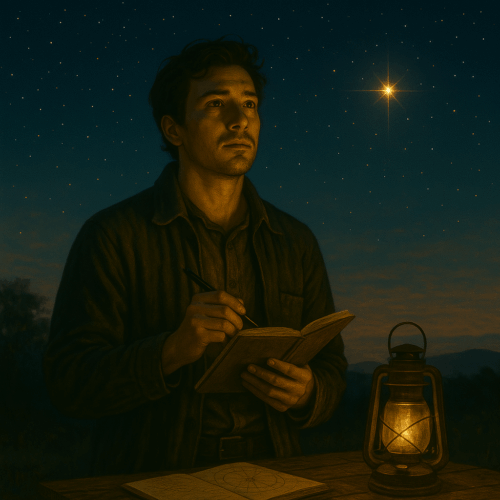
### Month Three: Visioning and Resilience
Week 9: Draft a “5-Year Supernova Vision.” Write a detailed description of where you want to be personally and professionally in five years.
Week 10: Identify one major obstacle that could derail this vision. Brainstorm three contingency strategies and document them.
Week 11: Implement a resilience practice of your choice—yoga, daily meditation, or creative art—at least three times this week. Note emotional and mental shifts.
Week 12: Host a “Milestone Ceremony.” Share progress with peers or document it visually (timeline poster, video montage, celebratory journal entry).
## Carrying the Stellar Legacy
From ancient Chinese towers to modern radio dishes, the supernova of 1054 weaves a story of curiosity, collaboration, and wonder. By embedding these principles into your daily life—through observation, interdisciplinary exchange, and long-term vision—you mirror the perseverance that turned a fleeting medieval flash into a cornerstone of modern science. Let this cosmic beacon illuminate your path, reminding you that single moments of brilliance can resonate across centuries and shape the trajectories of countless lives.

